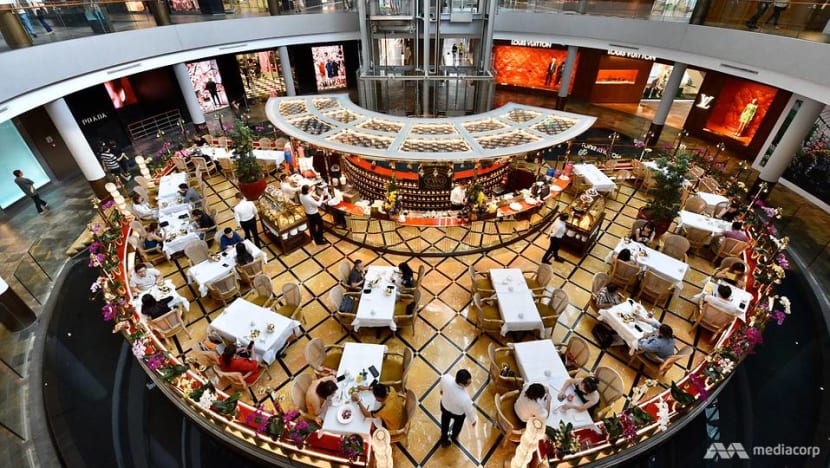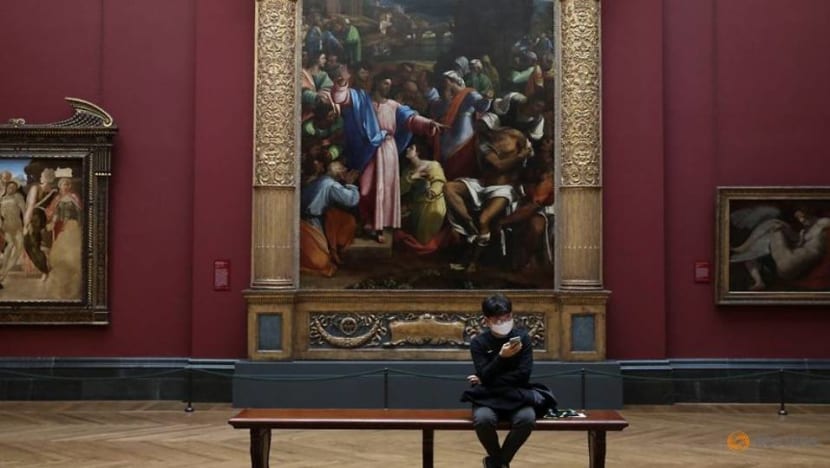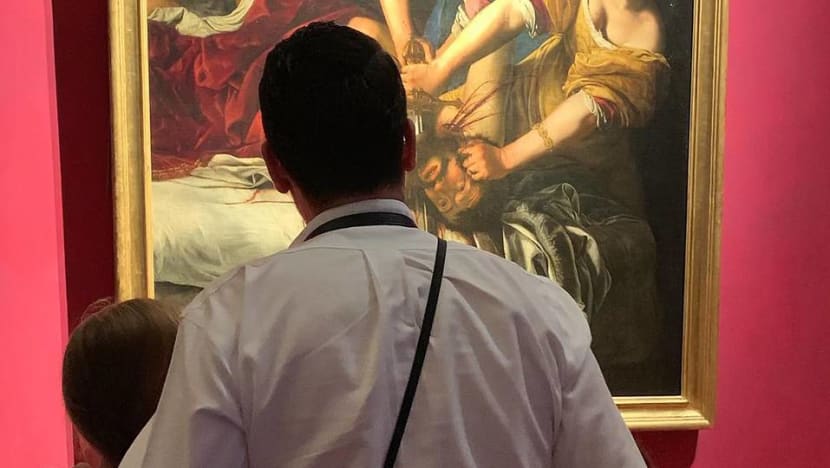commentary Commentary
Commentary: Museums and performing arts turned to Zoom to survive. But spectators find the experience frustrating
Technology allowed us to enjoy things we didn’t know we could during COVID-19. But a computer screen simply cannot capture certain activities and experiences, says Christian Barker.

SAM's curator tours go online with the launch of the new series, Virtual Curator Tours. (Photo: Singapore Art Museum)
SINGAPORE: When travel screeched to a halt early this year, companies trading internationally quickly adjusted to holding meetings or discussions via Zoom and similar tech tools.
This new way of communicating proved efficient enough that many experts predict business travel will never return to pre-crisis levels. Zoom did so phenomenally well, its stock price is now six times higher than it was this time last year. The nine-year-old company is now worth more than tech stalwart IBM.
It’s become clear that we don’t need to spend the time and money to travel across the globe (or even just across the city) simply to chat with one another.
We’ve become used to conducting many everyday interactions over a computer screen – birthday parties, school, dating, even concerts went online during the pandemic.
But in most circumstances, the digitally enabled experience remains a lacklustre substitute for the real thing.
READ: Commentary: Virtual corporate Christmas parties aren't so bad
READ: Commentary: The office Secret Santa gift exchange can be a landmine
Dining is one example. With apps on our smartphones, we can have dishes from the best restaurants in town delivered to our door.
Yet, no matter how fantastic the cuisine, the meal will never rival eating at the restaurant itself.
That’s because when it comes to almost any dining experience beyond the most basic, food is just one part of the equation.

There’s also the decor and ambience, the service, the sense of theatre and the fact that we’re surrounded by other people enjoying the occasion in the same way we are.
This is true whether you’re seated at a bustling hawker centre or a solemn, Michelin-starred temple to haute-gastronomy.
READ: Commentary: We are becoming a 'dabao nation' – why does it feel like a bad thing?
CAN MUSIC MOVE YOU ONLINE?
It’s a similar story with concerts. While live performances have resumed at select venues in Singapore from Nov 1, there’s a cap of 100 attendees, safe distancing protocols and other restrictions to follow.
From orchestral and jazz to pop, hip-hop or rock, we go to these communal events not just to hear music but to be a part of something larger – to join dozens, hundreds or thousands of others who love a particular artist or genre as much as we do.
We go to experience a form of mass hysteria. We go to bask in the presence of outstanding talent. That simply does not happen streaming a concert to our TV or laptop at home, in the company of no one beyond our close family.
READ: Commentary: COVID-19 has shown Singapore digital arts and humanities are quite the essential service
Attending a musical performance in person, the sound resonates in your belly, in your bones. At home, no matter how amazing your entertainment system or set of headphones, the acoustics can’t come close to those of a basement bar, nightclub, concert hall or arena.
In your living room, you might hear the music, but you won’t feel it.
UNWILLING TO PART WITH CASH FOR A LIVE STREAM
As live gigs have been virtually impossible over the last eight months, many musicians, bands and DJs have staged performances for streaming or on social media.

Cellist Yo-Yo Ma, for example, has presented a wonderfully soothing series called #SongsOfComfort via his Instagram account. At the other end of the energy spectrum, Zouk nightclub hosted several “virtual raves” featuring the likes of Diplo and local rapper Yung Raja.
Some musicians have performed online to earn money – most successfully, Korean boy-band BTS, whose two online concerts this year are estimated to have grossed in excess of S$70 million in total sales.
The majority of performers, however, have played digital shows mainly for the love of it, with little expectation of financial return.
READ: Commentary: BTS management's stock listing is a sign K-Pop is no passing fad
Sadly, that’s a realistic attitude, because apart from the rabid “stans” of the BTS Army, few members of the general public are content to pay for the privilege of watching musicians play onscreen.
With countless concert videos already viewable online for free, most people think,
why pay? Especially in the midst of a recession, when money’s particularly tight.
Those that are willing to part with cold, hard cash to watch a live-streamed musical performance are often motivated more than anything else by altruism – a wish to help a struggling musician stay afloat.
READ: Commentary: Making music online as a community lets us do together what is rarely possible alone
LIMITED INTEREST IN VIRTUAL ART TOURS
Art galleries, empty or shuttered due to social distancing measures and lockdowns, have attempted to raise much-needed funds by charging for virtual guided tours.
Like digital concerts, interest is limited because the experience pales in comparison to the real deal.

The big difference is, for music, a certain number of hardcore fans will shell out to see major acts like Dua Lipa, Justin Bieber or BTS – whereas in visual art, even the blockbusters aren’t pulling in paying crowds.
The curator of the in-demand (in real life, at least) Artemisia Gentileschi exhibition currently taking place behind closed doors at London’s National Gallery, Letizia Treves admitted in a recent interview that she herself hadn’t partaken of many virtual gallery tours during 2020.
The experience could be frustrating, she said.
It seems the public agrees. A half-hour virtual video tour of the Gentileschi exhibition, hosted by Treves and priced at £8 (S$14) per person, has been viewed by just a few hundred “visitors” per day.
READ: Commentary: We will miss Singapore's nightlife scene sorely if it dies
READ: Commentary: I miss my regular bar – but I accept I might never get to return, even after circuit breakers are lifted
ART NEEDS TO BE SEEN FOR REAL
Personally, I understand the relative lack of interest. Art needs to be seen for real.
In the 1980s my father took me to an expansive exhibition of Pop Art held in Brisbane, Australia. I was already familiar with the work of Andy Warhol, Robert Rauschenberg, Jasper Johns, Roy Lichtenstein et al from seeing it in books, but viewing these famous artworks in real life brought new colour, new dimension, new value – and vitally, scale.
What was so small on the page was so vast and imposing in real life. What was flat and “plastic” in print was incredibly organic, painterly and human on canvas.
Hoping to give my daughters a similar experience, last year, I took them to the Uffizi gallery in Florence, Italy. Viewing great works of Renaissance art (including a couple of iconic Gentileschis) in the city where many of them were created 500 years ago, my girls were absolutely enthralled.

It would seem terribly anti-climactic to now to take them on a virtual tour of a far-flung gallery via the iPad screen they spend all day staring at anyway. So I choose not to.
There were high hopes that the fashion industry would come up with innovative solutions to staging runway shows for remote audiences, and some have presented impressive digital spectacles.
But critics say the virtual fireworks generally detract from what should be the central focus – the clothes. To judge them properly, garments need to be seen up close, which you can’t do on a laptop.
That’s why fashion journalists have always made the pilgrimage to Paris, Milan and New York for the shows — and will once again when they can.
READ: Commentary: Missing the thrill of dressing up for work as a man
We’re incredibly fortunate to have the technology that we do, otherwise 2020 would’ve been even more of a nightmare.
Nevertheless, to enjoy certain experiences at home in anywhere near the richness of real life, virtual reality tech will have to vastly improve – and stop causing awful headaches. This year has been enough of a pain, hasn’t it?
Christian Barker is a Singapore-based journalist and editor who covers luxury, travel, business, culture and men’s style.














